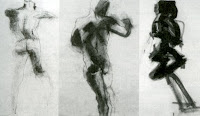
In a few more days, the evening drawing class will begin working from a live model. We've been exploring gesture during the last few classes in preparation. Everyone in class has now had experience doing short poses, so the empathetic process is starting to solidify. After last Thursday's session, I think many were exhausted by the end. We all stood at the drawing horses instead of sitting, allowing the gestural process to become more animated.
When a live model assumes a pose, especially the short ones for gestures, it's not a bad plan for those of us who are drawing to twist or bend in a similar pose to help us understand the nature of the movement the model is making, helping us to empathize with that energy. Then when we look up and down the figure it might be a little easier to see - even imagine - the line in the pose that summarizes the main force of the gesture. It might be the arc of the back, or a strong diagonal line through the torso and down one leg, such as in a contraposto position. Ideally, that line that we find will have a strong role to play in the model's movement: twisting, bending, turning. Then using your whole arm, not just your wrist, draw that line, that energy. Again, we're not worrying about detail here, we want the energy and the character of the movement. Stating the contour doesn't do it, we have to work from the inside out.
After that first forceful line, we continue searching with both our physical vision and our drawing utensil to find another complimentary and energetic line in the pose to include with the first; not thinking, just drawing, but maintaining the same priority of the energy of the pose, and of that first line Keeping a fast pace, we add other parts, but not as arms, legs, hair, etc., but rather as lines of energy that act in tandem with those already on the page.
Gesture drawing is an excellent warm up exercise every time we draw, even when we're working on something less animated than a live model. See you in the studio.











